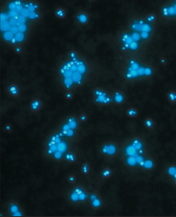Groups of Archaea
To date, four major clades of archaea have been identified. Biologists continue to debate how these clades are related to one another.
CRENARCHAEOTES
The crenarchaeotes (kren AHR kee ohts) include organisms that live in the hottest and most acidic environments known. Most of the known species have been isolated from thermal vents and hot springs—the prefix cren- means “spring.” Some species grow using organic compounds as energy sources, but others fix carbon from carbon dioxide, using hydrogen or sulfur to provide chemical energy.

Sulfolobus archaea thrives in acidic and sulfur-rich environments and experiences optimal growth at 80º Celsius. (SEM 33,200X)
KORARCHAEOTES
Scientists recently discovered the korarchaeote (kawr AHR kee oht) lineage in Obsidian Pool, Yellowstone National Park, and have since discovered more species in Iceland. Their DNA sequences place them apart from other archaea. The korarchaeotes may in fact be one of the least-evolved lineages of modern life that has been detected in nature so far.

Korarchaeotes from Obsidian Pool are shown in a lab culture with other microbes from their community. (SEM 6000X)
EURYARCHAEOTES
The euryarchaeotes (yoor ee AHR kee ohts) are a very diverse group of archaea, living in a broad range of habitats. The prefix eury- comes from a Greek word meaning “broad.” The methanogens are a major group of euryarchaeotes that play essential roles in the environment. They help to break down organic compounds in oxygen-poor environments, releasing methane gas in the process. Another group, the Halobacteria, are found in salt ponds, where the concentration of sodium chloride approaches saturation.

Colony of Methanosarcina archaea (SEM 40,000X)
NANOARCHAEOTES
Only a single species of this group has been discovered, in 2002, attached to a much larger crenarchaeote! Nanoarchaeotes (na noh AHR kee ohts) grow in hot vents near the coastal regions of the ocean and show definite molecular differences from other archaea. More research is needed to characterize this group, but what is known is that they have the smallest known genome of any organism.

The newly discovered Nanoarchaeum equitans (smaller cells) is shown attached to its host, genus Ignicoccus (larger cells). (LM 2000X)
Table of Contents
- Formulas and Equations
- Applying Formulas and Equations
- Mean, Median, and Mode
- Estimation
- Using Measurements in Calculations
- Effects of Measurement Errors
- Accuracy
- Precision
- Comparing Accuracy and Precision
- Significant Figures
- Calculating With Significant Figures
- Scientific Notation
- Calculating With Scientific Notation
- Dimensional Analysis
- Applying Dimensional Analysis




